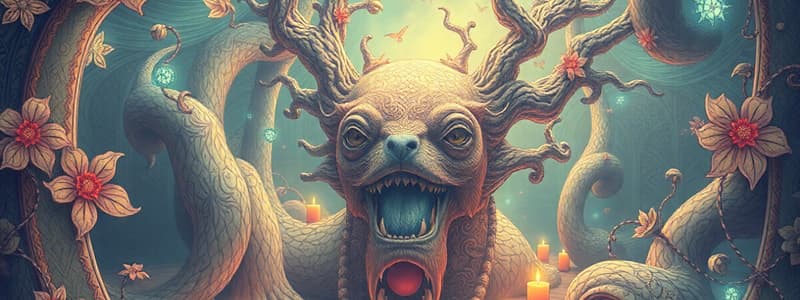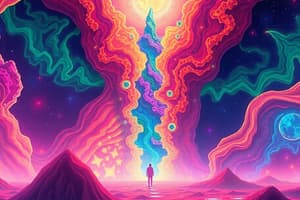Podcast
Questions and Answers
Which of the following is a characteristic of the psychic phase of drug effects?
Which of the following is a characteristic of the psychic phase of drug effects?
- Increased physical coordination and balance
- Changes in mood and altered perception of time (correct)
- Euphoria with no accompanying distressing thoughts
- Enhanced logical thought and increased vigilance
What phenomenon is associated with hallucinogens that involves distressing, spontaneous, recurrent experiences?
What phenomenon is associated with hallucinogens that involves distressing, spontaneous, recurrent experiences?
- Tolerance
- Flashback (correct)
- Dissociation
- Psychotic episode
What effect occurs as a result of rapid psychological tolerance to hallucinogens?
What effect occurs as a result of rapid psychological tolerance to hallucinogens?
- Increased drug effectiveness over time
- Complete physical dependence develops
- Cross-tolerance with psychedelics like LSD (correct)
- Permanent structural changes in the brain
HPPD is characterized by which of the following?
HPPD is characterized by which of the following?
Which symptom is intensified by hallucinogen use?
Which symptom is intensified by hallucinogen use?
What is the primary mechanism through which ketamine exerts its effects?
What is the primary mechanism through which ketamine exerts its effects?
Which of the following is a psychological effect experienced at low doses of ketamine?
Which of the following is a psychological effect experienced at low doses of ketamine?
How long does ketamine generally remain in the system, based on its elimination half-life?
How long does ketamine generally remain in the system, based on its elimination half-life?
What is the highest risk associated with ketamine use?
What is the highest risk associated with ketamine use?
What is a key characteristic of ketamine's impact on physical responses during high doses?
What is a key characteristic of ketamine's impact on physical responses during high doses?
What is a characteristic effect of small doses of LSD?
What is a characteristic effect of small doses of LSD?
At which serotonin receptors does LSD primarily exert its effects?
At which serotonin receptors does LSD primarily exert its effects?
What are common physiological effects of LSD use?
What are common physiological effects of LSD use?
What is the typical duration of action for LSD?
What is the typical duration of action for LSD?
What is the primary goal when treating intoxication?
What is the primary goal when treating intoxication?
Which of the following drugs is structurally similar to LSD?
Which of the following drugs is structurally similar to LSD?
Which medication is mentioned as useful for reducing agitation in intoxicated individuals?
Which medication is mentioned as useful for reducing agitation in intoxicated individuals?
What psychological benefit can LSD provide in psychotherapy?
What psychological benefit can LSD provide in psychotherapy?
What long-lasting severe effects may occur due to intoxication?
What long-lasting severe effects may occur due to intoxication?
How is LSD primarily excreted from the body?
How is LSD primarily excreted from the body?
What is a common misconception about the toxicity of LSD?
What is a common misconception about the toxicity of LSD?
What is a recommended strategy for managing a severely agitated intoxicated patient?
What is a recommended strategy for managing a severely agitated intoxicated patient?
Which of the following is NOT a recommended treatment approach for intoxication?
Which of the following is NOT a recommended treatment approach for intoxication?
What is the primary source of mescaline?
What is the primary source of mescaline?
What is one of the notable effects of MDMA?
What is one of the notable effects of MDMA?
What mechanism does MDMA primarily use to exert its effects?
What mechanism does MDMA primarily use to exert its effects?
How long do the visual effects of mescaline typically last?
How long do the visual effects of mescaline typically last?
Which of the following is a potential psychological effect of MDMA?
Which of the following is a potential psychological effect of MDMA?
What serious physiological condition can result from high doses of MDMA?
What serious physiological condition can result from high doses of MDMA?
What is a risk associated with long-term use of MDMA?
What is a risk associated with long-term use of MDMA?
Which symptom is associated with both mescaline and MDMA use?
Which symptom is associated with both mescaline and MDMA use?
What is the primary characteristic of hallucinogens at high doses?
What is the primary characteristic of hallucinogens at high doses?
Which pharmacological effect is NOT associated with low doses of anticholinergic scopolamine?
Which pharmacological effect is NOT associated with low doses of anticholinergic scopolamine?
What condition might develop due to the use of anticholinergics?
What condition might develop due to the use of anticholinergics?
Which symptom is characteristic of the anticholinergic syndrome caused by scopolamine?
Which symptom is characteristic of the anticholinergic syndrome caused by scopolamine?
What is the primary function of the antidote physostigmine in relation to scopolamine?
What is the primary function of the antidote physostigmine in relation to scopolamine?
In what duration do the psychotic effects of scopolamine typically clear after use?
In what duration do the psychotic effects of scopolamine typically clear after use?
What effect might result from the use of higher doses of scopolamine?
What effect might result from the use of higher doses of scopolamine?
What is the primary active molecule in Psilocybin after metabolism?
What is the primary active molecule in Psilocybin after metabolism?
Which of the following is true regarding the withdrawal symptoms from scopolamine use?
Which of the following is true regarding the withdrawal symptoms from scopolamine use?
How long do the effects of Ayahuasca typically last?
How long do the effects of Ayahuasca typically last?
What is a common route of administration for Ketamine?
What is a common route of administration for Ketamine?
What receptors do Psilocin predominantly act as an agonist for?
What receptors do Psilocin predominantly act as an agonist for?
What is the peak onset time for the effects of PCP?
What is the peak onset time for the effects of PCP?
What potential benefit does Ketamine offer as an antidepressant?
What potential benefit does Ketamine offer as an antidepressant?
What is the typical duration of effects for Psilocybin and Psilocin?
What is the typical duration of effects for Psilocybin and Psilocin?
Which of the following substances is known for producing dissociative states?
Which of the following substances is known for producing dissociative states?
Flashcards
Psychedelics
Psychedelics
Drugs that alter perception, cognition, and mood, leading to changes in consciousness and potentially hallucinations.
Hallucinogen
Hallucinogen
A substance that induces hallucinations, or perceptions without corresponding sensory input. Hallucinations are rare; illusions and distorted perceptions are more common.
Psychotomimetic
Psychotomimetic
A drug that mimics or induces psychotic states, but does not produce the same behavioral patterns as true psychosis.
Anticholinergic Scopolamine
Anticholinergic Scopolamine
Signup and view all the flashcards
Antimuscarinic
Antimuscarinic
Signup and view all the flashcards
Scopolamine's PNS effects
Scopolamine's PNS effects
Signup and view all the flashcards
Scopolamine's CNS effects (Low Doses)
Scopolamine's CNS effects (Low Doses)
Signup and view all the flashcards
Scopolamine's CNS effects (High Doses)
Scopolamine's CNS effects (High Doses)
Signup and view all the flashcards
Mescaline Structure
Mescaline Structure
Signup and view all the flashcards
Mescaline Source
Mescaline Source
Signup and view all the flashcards
Mescaline Effects
Mescaline Effects
Signup and view all the flashcards
Sensory Distortions
Sensory Distortions
Signup and view all the flashcards
Mescaline Administration
Mescaline Administration
Signup and view all the flashcards
MDMA Mechanism
MDMA Mechanism
Signup and view all the flashcards
Psychic Phase
Psychic Phase
Signup and view all the flashcards
MDMA Psychological Effects
MDMA Psychological Effects
Signup and view all the flashcards
Tolerance and Dependence
Tolerance and Dependence
Signup and view all the flashcards
MDMA Physiological Effects
MDMA Physiological Effects
Signup and view all the flashcards
Flashbacks
Flashbacks
Signup and view all the flashcards
MDMA Potential Dangers
MDMA Potential Dangers
Signup and view all the flashcards
HPPD (Hallucinogen Persisting Perception Disorder)
HPPD (Hallucinogen Persisting Perception Disorder)
Signup and view all the flashcards
Ketamine
Ketamine
Signup and view all the flashcards
Mechanism of Action: NMDA receptor antagonist
Mechanism of Action: NMDA receptor antagonist
Signup and view all the flashcards
Psychological Effects: Low Doses
Psychological Effects: Low Doses
Signup and view all the flashcards
Psychological Effects: High Doses
Psychological Effects: High Doses
Signup and view all the flashcards
Safety of Ketamine
Safety of Ketamine
Signup and view all the flashcards
Serotoninergic Psychedelics
Serotoninergic Psychedelics
Signup and view all the flashcards
LSD Mechanism
LSD Mechanism
Signup and view all the flashcards
LSD Effects
LSD Effects
Signup and view all the flashcards
LSD Hallucinations
LSD Hallucinations
Signup and view all the flashcards
LSD in Psychotherapy
LSD in Psychotherapy
Signup and view all the flashcards
LSD Pharmacokinetics
LSD Pharmacokinetics
Signup and view all the flashcards
LSD Physiological Effects
LSD Physiological Effects
Signup and view all the flashcards
LSD Toxicity Level
LSD Toxicity Level
Signup and view all the flashcards
Scopolamine Toxicity
Scopolamine Toxicity
Signup and view all the flashcards
Scopolamine Intoxication Treatment
Scopolamine Intoxication Treatment
Signup and view all the flashcards
Scopolamine Overdose Complications
Scopolamine Overdose Complications
Signup and view all the flashcards
Scopolamine Effects
Scopolamine Effects
Signup and view all the flashcards
Scopolamine Overdose: Long-Term Impact
Scopolamine Overdose: Long-Term Impact
Signup and view all the flashcards
Ayahuasca
Ayahuasca
Signup and view all the flashcards
Psilocybin
Psilocybin
Signup and view all the flashcards
Psilocin
Psilocin
Signup and view all the flashcards
NMDA Receptor Antagonist
NMDA Receptor Antagonist
Signup and view all the flashcards
Phencyclidine (PCP)
Phencyclidine (PCP)
Signup and view all the flashcards
Psilocybin's Peak Effect?
Psilocybin's Peak Effect?
Signup and view all the flashcards
Ketamine's Peak Effect?
Ketamine's Peak Effect?
Signup and view all the flashcards



